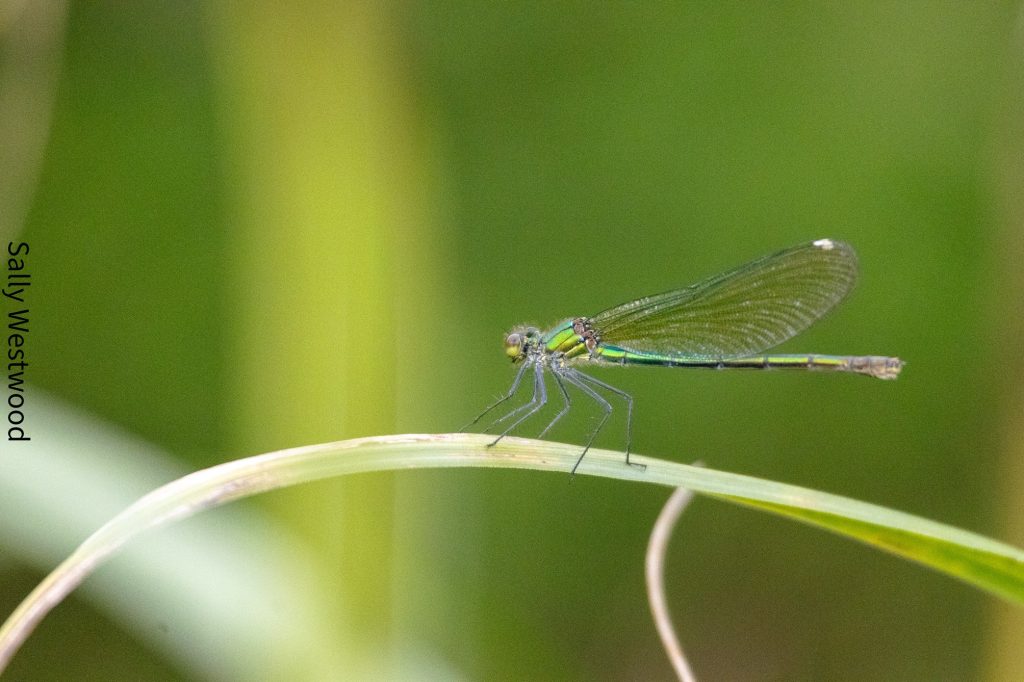By Sally Westwood
I observed a large damselfly in late July whilst walking alongside the slow flowing, fresh water stream that runs parallel to the Deben, near Wilford Bridge. Banded Demoiselles Calopteryx splendens are mostly seen during June and July on sunny afternoons, although you may see them in August and September. Male and female Banded Demoiselles have a striking pattern and colour. The female in the image below, has a metallic emerald thorax and abdomen, with a bronze red tip to the abdomen. The last three abdominal segments have a yellow line1. The males and females both have translucent light green wings. The females have a small white mark, or pterostigma at the wing tip, whereas the males have no pterostigma2. Both males and females are 48mm or 1.4 inches in length and their hindwing can be 36mm or 1.4 inches long. This species is present throughout Britain but not in the Scottish highlands. It is common in much of Central Europe including Germany, France, and Poland but absent from European countries that are cold, for example, Scandinavia and those countries that are dry, such as Spain. Their range extends into central and Western Asia. Habitat becomes problematic when flowing freshwater is scarce.
Banded Demoiselle Calopteryx splendens
The Azure damselfly Coenagrion puella is a small, slight delicate species in comparison to the Banded Demoiselle although all damselflies are rather delicate, fragile creatures when considering their structure and composition. The structure of the damselfly with the example of an Azure damselfly, is shown below3. The Azure frequently appears at the river edge when the tide is low with exposed grasses and reeds, particularly when there is a pond on the other side of the river path, on land owned by houseboat dwellers. It prefers standing water hence its preference for ponds and relatively still edges of the river. The male Azure damselfly is black and bright blue, whereas the female has a bright green and black thorax with the same blue and black
Structure of the (Azure) Damselfly
Source: British Dragonfly Society, 2025.
sections on the abdomen as the male4. The species may be seen from late April to early September, busy skimming water for insects, or fluttering over water at one or two miles per hour. Damselflies tend to make short fluttering trips from perches on grasses or reeds to catch their prey. By comparison, dragonflies chase prey in mid-air and are capable of flying at twenty miles per hour. The flight of the damselfly is graceful and more like ballet in comparison to the high speed aerodynamics of the powerful dragonfly.
Azure Damselfly
In June, I observed the Large Red Damselfly Pyrrhosoma nymphula in the same location on the river as the Azure. It occurs in wetland habitats and is observed in similar ponds, and still water as the Azure damselfly, with a similar dislike for fast flowing water. The male Large Red has a red abdomen with some black markings, whereas the female may be mostly red, or mostly black, alternatively some may have yellow markings on the thorax as the male5. The species is about
Large Red Damselfly
33-36mm long and of similar length to the Banded Demoiselle. The Large Red is widespread in the UK and may be seen from early April to late August6. Unlike other damselflies, all adult Large Reds have a “synchronised emergence”7 from water during the same period of three weeks in early spring, although some emerge later in the summer and miss synchronisation. In the life cycle of the damselfly, the adult stage of life may be about 4 weeks, or less. It is the shortest
Life Cycle of the (Azure) Damselfly
period of their lives, which is set aside for feeding, mating, laying eggs and dying. The egg stage is only a few weeks, whereas the larval stage is between 1-2 years. Synchronization may occur as a “predator-satiation strategy” because birds, frogs and fish can only eat so many damselflies8.
This maximises mating and all fully develop, mate and lay eggs at the same time9. Damselflies in shallow water margins are more prone to being eaten by predators10. A remarkable 50% of newly emerged Large Reds are eaten in shallow water margins, when they still have soft bodies and are not ready to fly.
The dangers associated with shallow water margins are not applicable for those damselflies that develop with prolonged or asynchronous emergence. The Azure and, for example, the Blue-tailed Ischnura elegans damselfly usually occur in well vegetated, more permanent and deeper water, with less predators present at the water margins11. The latter species is a “summer continuous species”12. which appears over a period of 8-10 weeks13. In contrast Large Reds are “spring peak species”. Whereas, the Azure damselfly has a prolonged emergence14.

Azure Damselfly mating
I had observed the Azure both ovipositing and in copular, laying eggs and mating, engaged in the reproductiveprocess, in the same body of water with developed vegetation, at the side of the river, mentioned above, as the Large Red, where it was perching and feeding, not engaged in the reproductive process. This observation can be accounted for by the different types of adult emergence. Large Reds mate when the vegetation is low, however, Azures emerge later than the Large Reds when vegetation is more developed. This is shown in the graph below15. Large Reds emerge during mid-April, whereas Azures have a prolonged emergence from May to July.
Source: Sally Westwood
Perhaps rather surprisingly the Banded Demoiselle, the Azure and the Large Red damselfly are doing rather well in their habitats. They are both considered common and at least risk of decline, unlike some damselflies. There are seventeen resident damselflies in the UK, however, six of these are considered endangered, near threatened, or scarce16. The Southern damselfly Coenagrin mercuriale and the Northern damselfly Coenegrion hastalatum are endangered. The Southern damselfly prefers slow flowing streams, like the Azure damselfly above, however, the southern has specific habitat needs, they need water to flow over gravel, with areas of organic detritus. Their habitat is mainly restricted to two chalk based rivers in Hampshire and Pembrokeshire that are characteristic of similar sites on the continent. Drainage stemming from agricultural processes threatens their habitat.
The Northern Damselfly also has a specific habitat of shallow water in the Scottish highlands with two specific plants, horsetails and sedges. Threats to their small handful of habitat frequently results from natural succession. The Variable damselfly Coenagrion pulchellum, Scarce Blue-tailed damselfly Ischnura pumillio, and the Scarce Emerald damselfly Lestes dryas are recorded as near threatened. The Variable damselfly prefers a habitat of highly vegetated canals, ponds and ditches which are mainly in Wales. Threats are likely from land drainage from agricultural processes.The Scarce Blue-tailed damselfly prefers a habitat that is disturbed by human activity, with shallow, slow flowing water with minimal plants and vegetation, and bare substrate. Habitat threats include reworking of quarry sites resulting in the drying out of pools and streams.
Scarce Emerald Damselfly
Source: https://britishwildlife.fandom.com/wiki/Scarce_Emerald_Damselfly
The Scarce Emerald damselfly prefers shallow water that is rich in vegetation. It has similar iridescent colouring as the Banded Demoiselle above, however it has blue eyes and black anal appendages. The Scarce Emerald breeds in a handful of lakes in Norfolk and near the Thames estuary in Essex17.This species has problems with falling water levels since they lay their eggs near temporary pools18. Once hatched into larvae, these species have to grow rapidly before water levels drop and the pond dries out. They complete their larvae growth in eight weeks, unlike the one or two years taken by other species. The Small Red damselfly Ceriagrion tenellum is considered nationally scarce. The Small Red is restricted to pools, bog and shallow pools in heathland in west Wales and southern England. Threats arise from unmanaged heathland and encroachment from wild plants.
It seems that the six endangered or rare damselflies each have specific habitat requirements that are tied to particular areas, consequently they are likely to be negatively impacted when their habitat disappears. Fortunately, the three common damselflies discussed above, that occur around the Deben, may be able to relocate to a similar habitat with slow or standing water, not too far away.
Sally Westwood

Sally Westwood is a Psychologist, and works as a researcher. She has taught in higher education as an English Language teacher. Her interests are varied. She has written many articles for Bird Magazines and Journals. She is also a professional bird photographer. Birds are her passion. She loves to draw and paint birds. She lives on a boat on the Deben and loves to sit and be with the birds, simply watching and photographing birds, in their daily activities.
Footnotes
1McGeeney, A. (1986) A complete guide to British dragonflies. Jonathan Cape.
2Brooks, S. (2004) Field Guide to the Dragonflies and Damselflies of Great Britain and Ireland. British Wildlife Publishing.
3BritishDragonflySociety. (2025) Characteristics of Damselflies. Available from: https://british-dragonflies.org.uk/odonata/damselflies/ [Retrieved 28 August 2025].
Brooks, S. (2004), as above.
4British-Dragonflies.org.uk (2025) Large Red Damselfly. Available from: https://british-dragonflies.org.uk/species/large-red-damselfly/ [Retrieved 28 August 2025].
54Wildlife.Trust.org (2025) Large Red Damselfly. Available from: https://www.wildlifetrusts.org/wildlife-explorer/invertebrates/damselflies/large-red-damselfly [Retrieved 28 August 2025].
6 odonata.org.uk (2022) Anticipating Large Reds. Available from: https://www.odonata.org.uk/2022/anticipating-large-reds/ [Retrieved 28 August 2025].
7 Corbet, P. S. (2004) Dragonflies: Model Organisms for Ecological and Evolutionary Research. Open University Press
8Lawton, J. H. (1970) Feeding and emergence in Pyrrhosoma nymphula (Sulzer). Freshwater Biology 1: 99-111
9Corbett, P. S.(1999) Dragonflies: Behaviour and Ecology of Odonata. Cornell University Press.
10Lawton, J. H. (1970) As above.
11Corbet, J. H. (1999) As above.
12Lawton, J. H. (1970) As above.
13Corbet, P. S. (2004) As above. Banks, M. J. (1990) Emergence behaviour of the damselfly Ischnura elegans (Vanderbilt Linden): a multivoltine species in Britain. Freshwater Biology 2: 21-34.
14Dijkstra, K. D. B. & Lewington, P. (2006)
15Graph is based on data derived from Dijkstra, K. D. B. & Lewington, P. (2006), and Corbett, P. S. (1999), as above.
16 odonata.org.uk (2008) British Odonata Red List 2008. Available from: https://www.google.com/search?q=british+odonata+redlist&ie=UTF-8&oe=UTF-8&hl=en-gb&client=safari [Retrieved 28 August 2025]
17 odonata.org.uk (2022) The Scarce Emerald Damselfly Lestes dryas. Availablefrom:. https://www.odonata.org.uk/species/lestes-dryas/ [Retrieved 28 August 2025].
18britishwildlife.fandom.com (2025) Scarce Emerald Damselfly. Available from:
https://britishwildlife.fandom.com/wiki/Scarce_Emerald_Damselfly [Retrieved 28 August 2025].







